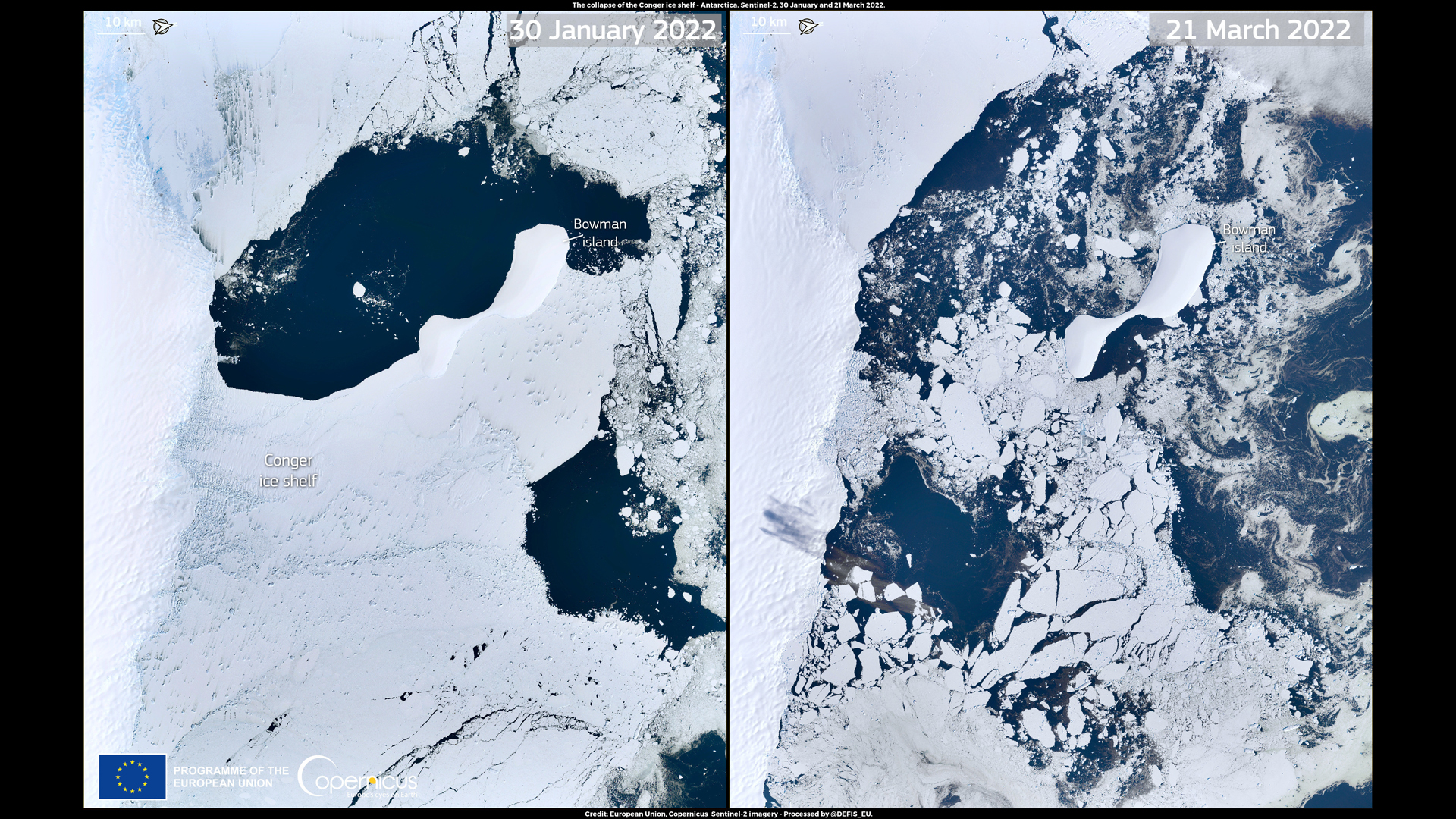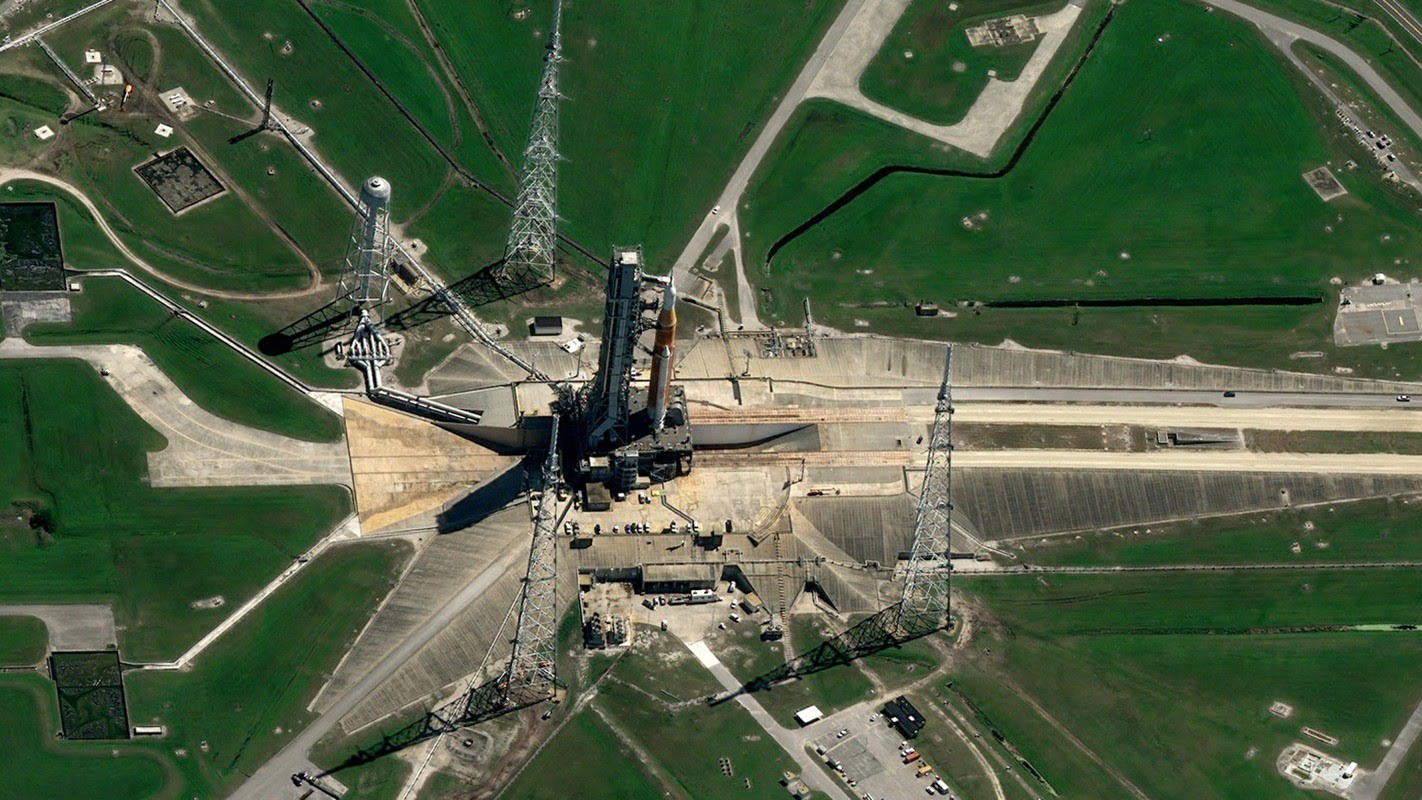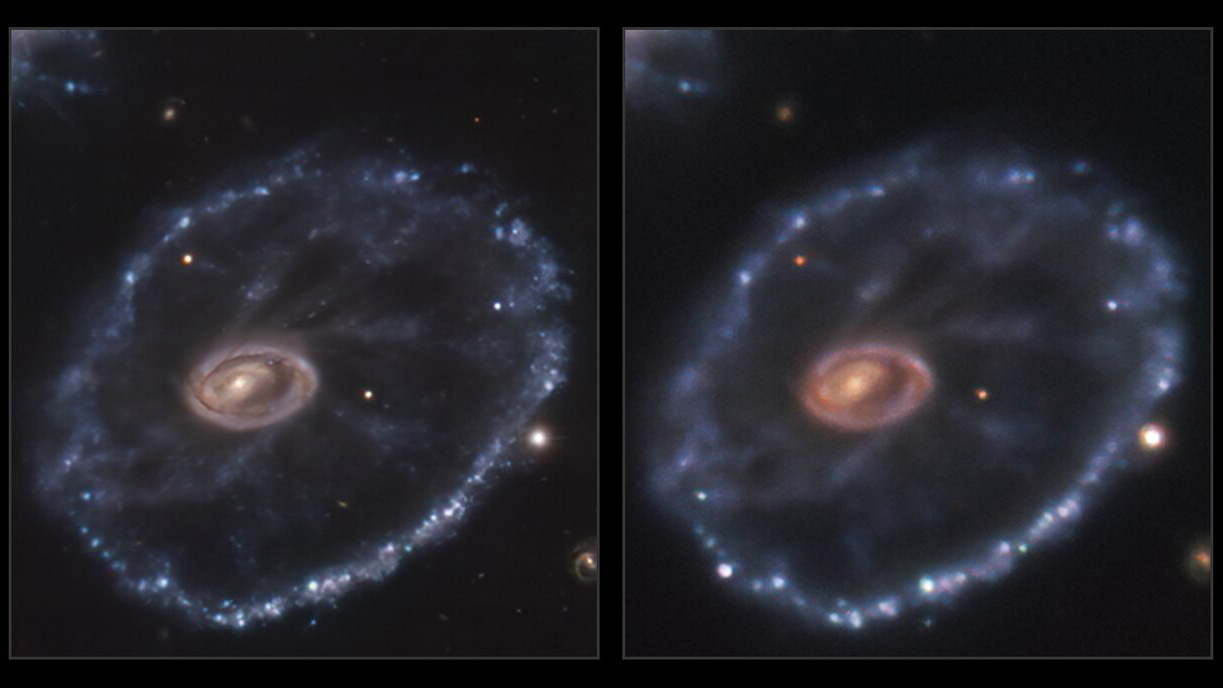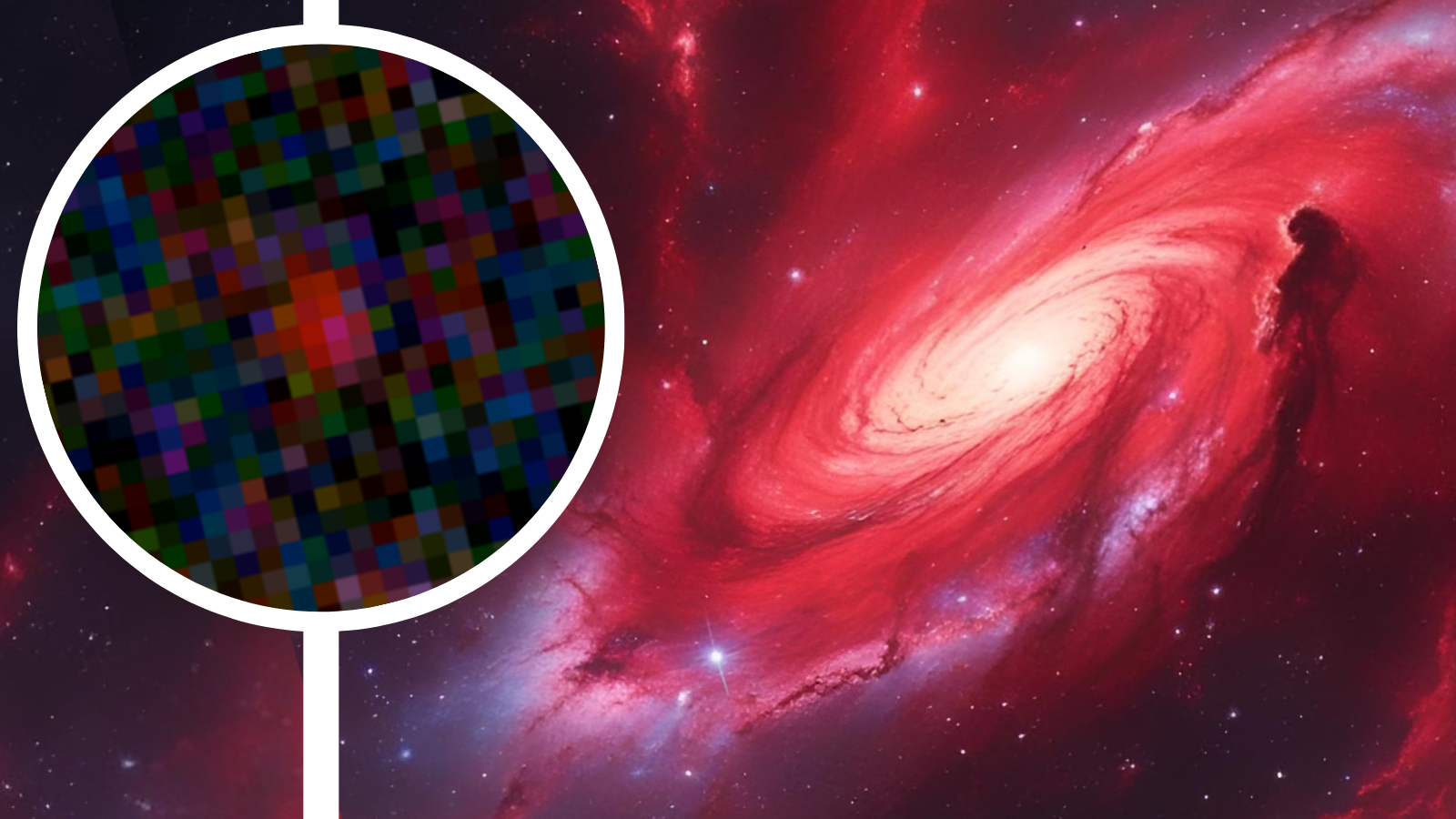March 2022
Satellite spots aurora in black and white from orbit

Thursday, March 31, 2022: An American weather satellite spotted swirling aurora displays above the North Pole after two coronal mass ejections hit Earth on Thursday early morning, triggering a strong geomagnetic storm.
The satellite that captured this image is the polar orbiting NOAA-20 operated by the U.S. National Oceanic and Atmospheric Administration (NOAA), which circles the Earth from pole to pole seven times a day.
It acquired the image on Thursday morning at 2:57am EDT (0657) GMT as it flew over the U.S. Atlantic coast.
Skywatchers on Earth could observe the auroras from most of Canada. In the U.S., sightings as far south as Colorado have been reported. Auroras are usually visible only above polar regions, but strong geomagnetic storms triggered by coronal mass ejections, which frequently accompany solar flares, temporarily intensify the phenomena, making them visible from farther afield. Good aurora viewing conditions are expected to continue until at least Friday (April 1). – Tereza Pultarova
Brain terrain in Mars' largest impact basin

Wednesday, March 30, 2022: Strange structures resembling the human brain have been spotted by the European Mars Express orbiter in the Red Planet's largest impact basin.
The image, captured by the 18-year-old spacecraft in July 2021, reveals two craters surrounded by darkened warped terrain that somewhat resembles the folded texture of a brain.
In the case of Mars, the folds around these craters were likely created by the interaction between the soil and melting water ice.
Get the Space.com Newsletter
Breaking space news, the latest updates on rocket launches, skywatching events and more!
The craters are part of the 2,050-mile-wide (3,300 kilometers) Utopia Planitia, the largest known impact basin not only on Mars but in the entire solar system.
The true-color image was acquired by Mars Express' High Resolution Stereo Camera and shows the planet's surface with a resolution of about 62 feet per pixel (19 meters). – Tereza Pultarova
Satellites spot burping Krakatoa volcano

Tuesday, March 29, 2022: Satellites have spotted a minor eruption of the Krakatoa volcano in Indonesia, one of the world's most feared volcanoes.
A plume of smoke can be seen rising from Krakatoa's crater in this image, captured by the European Sentinel 2 satellite on Monday (March 28). The volcano is notorious for its 1883 eruption, the most devastating volcanic eruption in recorded history, which killed over 36,000 people. A collapse of the volcano's caldera in 2018 caused a tsunami that killed more than 400.
The volcano woke up again in February and has been monitored ever since. Krakatoa is known to produce large amounts of ash that could damage aircraft engines. – Tereza Pultarova
Satellites watch as Antarctic ice shelf collapses amid heatwave

Monday, March 28, 2022: European Earth observation satellites observed nearly in real time as a massive ice shelf in East Antarctica collapsed due to unusually high temperatures in mid-March.
The Conger ice shelf, 450 square miles (1,165 square kilometers) in size, was photographed by the Sentinel-2 satellite of the European Earth Observation program Copernicus on Jan 30 2022 (the image on the left), when it was still intact. When the satellite flew over the ice shelf again on March 21, all it saw was a sea full of floating ice rubble.
In the week prior to the collapse, record-breaking temperatures were measured in Antarctica.
East Antarctica’s climate was previously thought to be stable and not heavily affected by climate change, Copernicus said in a statement. An ice shelf collapse had never been registered in that area, the agency added.
Scientists say that the Conger ice shelf collapse is the second most significant ice shelf collapse since that of the Larsen B ice shelf in 2002.
Ice shelves are extensions of ice sheets floating over the ocean that slow down the flow of inland ice into the ocean, which is the main process responsible for sea level rise, Copernicus explained. – Tereza Pultarova
Spacewalkers do maintenance work on the space station

Friday, March 25, 2022: European astronaut Matthias Maurer performed his first ever spacewalk on Thursday (March 24), working with his American colleague Raja Chari to fix equipment around the orbital outpost.
During the spacewalk, which lasted nearly seven hours, the two astronauts installed some radiator hoses on a system that regulates the temperature inside the space station, replaced an external camera on the station's truss and installed a power and data cable on the Bartolomeo science platform outside the European Columbus module. – Tereza Pultarova
Mariupol theatre destruction seen from space

Thursday, March 24, 2022: Satellites of U.S. Earth observation company Planet captured this image of a theatre in the Ukrainian city of Mariupol after it had been destroyed by a Russian missile.
Hundreds of residents had been sheltering in the theatre, which is believed to have been deliberately targeted by Russian forces. On the left hand side of the image, the sign дети, children, in Russian, is clearly visible, an attempt by the Ukrainians to signal to the Russians not to target the place.
The theatre's underground air raid shelter, however, is believed to have survived the attack. – Tereza Pultarova
Floating robots meet on space station

Wednesday, March 23, 2022: Two floating robots have met for the first time aboard the International Space Station this week, although both have lived on the orbital outpost for more than two years now.
The Crew Interactive MObile companioN (CIMON), developed by the German Aerospace Center in cooperation with Airbus and IBM is an artificially intelligent assistant designed to help astronauts go about their everyday tasks.
The AstroBee, developed by a team at NASA's Ames Research Center, was designed to autonomously perform various tasks, such as monitoring the environment aboard the station.
This picture was taken by NASA astronaut Kayla Barron during the first meeting between the two robots. – Tereza Pultarova
Record-breaking heatwave hits Antarctica

Tuesday, March 22, 2022: The European Sentinel-3 satellite captured this image of Antarctica on March 18 as temperatures on the icy continent reached record highs for this time of the year.
Temperatures in parts of Antarctica were 72 degrees Fahrenheit (40 degrees Celsius) above long-term averages last week, reaching 10 degrees Fahrenheit (-12.2 degrees Celsius).
The Arctic, the icy cap around the North Pole, has also been experiencing exceptionally high temperatures. Scientists are unsure whether the two unusual heat waves can be related. – Tereza Pultarova
High-resolution satellite captures NASA's moon rocket on the pad

Monday, March 21, 2022: NASA's giant moon rocket, the Space Launch System (SLS), sits on a launch pad at Kennedy Space Center in Florida in a high-resolution image captured by a new European Earth observation satellite.
The image was captured by the Pléiades Neo satellite operated by aerospace company Airbus. Pléiades Neo provides images with 11-inch (30 centimeters) resolution, one of the highest commercially available.
Airbus didn't look for SLS by chance. The company developed the service module of the Orion crew capsule that sits atop the rocket in this image, ready for the upcoming wet dress rehearsal test that will pave the way for the uncrewed launch of the Artemis I mission later this year.
The rocket was rolled out from the iconic Apollo-era Vehicle Assembly Building last week and will be moved back after the wet dress rehearsal for final adjustments before the launch, which is currently planned for May.
The Artemis I. mission will test technologies for upcoming missions with astronauts that will eventually return humans to the surface of the moon. – Tereza Pultarova
Full moon watches over NASA's moon rocket launchpad roll-out

Friday, March 18, 2022: The arrival of NASA's new moon rocket at the launchpad at NASA's Kennedy Space Center in Florida coincided with the last winter full moon of 2022.
NASA's special hauler vehicle, the crawler transporter 2, delivered the 5.5 million-pound (2.5 million kilograms), 365-feet-tall (111 meters) Space Launch System (SLS) rocket from the Apollo-era Vehicle Assembly Building on Thursday (March 17).
The rocket will undergo a series of tests on the launch pad, including a wet dress rehearsal test, during which it will be fuelled and run through a simulated pre-launch countdown.
NASA will then move the rocket back to the Vehicle Assembly Building for final adjustments ahead of the unmanned launch of the Artemis 1 mission that will send an empty Orion capsule for a trip to the moon and back. The mission will test technologies ahead of a planned crewed mission in 2025. – Tereza Pultarova
Saharan dust covers Europe

Thursday, March 16, 2022: A massive plume of Saharan dust obscures the sky over western Europe as seen in this image captured by the European Earth-observation satellite Sentinel-3 on March 15.
The dust cloud, stirred up by storm Celia, which moved from north-western Africa to Europe earlier this week, was especially thick above Spain. The country's meteorologists described the event as "extraordinary" in its intensity and extent.
Air quality in western European countries including France, Portugal and Spain has suffered after the dust cloud, traveling on a wave of warm air from North Africa, spread in the atmosphere.
Authorities urged residents in the most affected communities to stay indoors to avoid breathing difficulties. In the Canary Islands, a Spain-controlled archipelago off the west coast of Morocco, several flights had to be canceled due to poor visibility. – Tereza Pultarova
James Webb Space Telescope's first image exceeds expectations

Wednesday, March 16, 2022: The James Webb Space Telescope teams have revealed the first image taken with the telescope's main mirror fully aligned.
The image captures a star called HD 84406, which, according to NASA, is rather uninteresting, having only been selected as Webb's first target because of its faintness and location in the sky.
The star is 100 times fainter than what humans can see with the naked eye, but Webb can see it bright and clear. And not only the star, but also dozens of galaxies in the distance that were out of reach of space observatories before. – Tereza Pultarova
Mini-asteroid discovered just before hitting Earth

Tuesday, March 15, 2022: A small asteroid on a collision course with Earth was discovered just a few hours before slamming into the planet off the coast of Iceland.
The asteroid, named 2022 EB5, was first spotted by Hungarian astronomer Krisztián Sárneczky on Friday (March 11) using a 24-inch (60 centimeters) telescope.
Subsequent observations confirmed the discovery and enabled astronomers to calculate the trajectory of the space rock, which, fortunately, was only a few meters in size.
Although no eye-witness accounts exist of the asteroid's ultimate encounter with the planet, data from an international network of infrasound sensors confirmed an impact between Iceland and Greenland, which produced mild local earth tremors comparable to a magnitude 4.0 earthquake. – Tereza Pultarova
Volcano erupts in Guatemala

Monday, March 14, 2022: The European Sentinel 2 satellite captured this image of the Fuego volcano in Guatemala on March 10.
Fuego is the most active of three volcanoes in the Central American country. Local authorities have recently reported increased activity including lava flows that may threaten nearby settlements. – Tereza Pultarova
Satellites watch Californian lake drying out

Friday, March 11, 2022: Images taken by the European Sentinel 2 Earth observing satellite over the past two years reveal receding water levels in California's drought-stricken Oroville reservoir.
The images were taken between March 31 2019 and March 10 2022, and show the shrinking water surface of the artificial lake on the Feather River in the Sierra Nevada foothills east of the Sacramento Valley in California.
According to media reports, water levels in lake Oroville reached an all time low in September 2021, forcing a local hydroelectric plant to shut down for the first time in history. – Tereza Pultarova
Moon rocket readies for launch-pad roll-out

Thursday, March 10, 2022: NASA engineers are retracting platforms that enabled them to assemble the space agency's 322-feet-tall (98 meters) moon rocket as they finalize preparations for the rocket's launch pad roll-out.
The Space Launch System (SLS) rocket has been put together at the iconic Apollo-era Vehicle Assembly Building at NASA's Kennedy Space Center in Florida. Later this year, the rocket will launch an uncrewed Orion astronaut capsule for a trip to the moon and back as part of the Artemis I mission, which will test the technology ahead of a crewed flight next year.
There are overall 10 work platforms, A to K, covering the full length of the rocket. In this image, shared by NASA on Twitter on Wednesday (March 9), only the middle platforms are still in place. – Tereza Pultarova
Satellite shows low levels of Arctic sea ice

Wednesday, March 9, 2022: The European Sentinel-2 Earth observing satellite captured this image of sea ice between Greenland and Iceland on March 7, 2022.
According to data from the European Union's Copernicus climate monitoring program, which runs the Sentinel satellites, the extent of Arctic sea ice in February 2022 was 2% below the average of the past 30 years, Copernicus said in a statement.
Ice covered 5.7 million square miles (14.7 million square kilometers) of sea in February 2022, 0.1 million square miles (0.3 million square kilometers) less than in average years. Moreover, the Arctic sea ice extent has been below average consistently since July 2021.
February 2022, Copernicus added, was the thirteenth consecutive February with a below average sea ice extent. – Tereza Pultarova
A 'deliberate' flood stops Russian troops in Ukraine

Tuesday, March 8, 2022: Earth-observation satellites of U.S. company Planet captured a flood near Ukraine's capital Kyiv, which is believed to have been caused deliberately to stop the invading Russian troops.
Planet's satellites captured the region north of Kyiv on Feb. 22 and Feb. 28. While the first image shows no flood, the second image reveals a wide area covered with water that was previously land. Analysts believe the water comes from a nearby dam.
Ukraine has been defending against an invasion by Russia since Feb. 24. Despite initial expectations that the country would be quickly taken over, the Ukrainian military, reinforced by civilian volunteers, has managed to cause significant losses to the more powerful Russian army.
The Ukrainians are defending their country alone as the international forces refuse to get involved out of fear of possible escalation that might lead to the deployment of nuclear weapons. –Tereza Pultarova
Telescope captures supernova explosion in distant galaxy

Monday, March 7, 2022: Astronomers have spotted a new supernova explosion in a distant galaxy.
The supernova explosion can be seen as the bright white dot in the lower left corner of the image on the right. The image was taken by the European Southern Observatory's New Technology Telescope (NTT) in December 2021. The image on the left is from August 2014.
The Cartwheel galaxy, in the constellation Sculptor, is some 490 million light years away from Earth. The newly discovered supernova, SN2021, is what astronomers call type II supernova, which occurs when massive stars burn up all the fuel in their core and collapse on themselves, triggering a massive explosion. Supernovae can cause a star to shine brighter than its entire host galaxy and can be visible to observers for months, or even years, ESO said in a statement. – Tereza Pultarova
NASA begins assembly of Jupiter icy moon explorer mission

Friday, March 4, 2022: NASA's Europa Clipper spacecraft that will explore Jupiter's icy moon Europa has started coming together at NASA's Jet Propulsion Laboratory in California.
Engineers began assembling the spacecraft, which will be as large as an SUV and featuring solar arrays as wide as a basketball court, after completing a series of project reviews in late 2021, NASA said in a statement.
Europa Clipper, expected to launch in 2021, will perform close flybys of the moon in search for conditions suitable for life. –Tereza Pultarova
The Earth still looking peaceful from space

Thursday, March 3, 2022: Nasa astronaut Mark Vande Hei is watching Earth roll underneath the space station as he nears the end of his mission.
Vande Hei is scheduled to return to Earth on Russia's Soyuz spacecraft on March 30 after a record-breaking 355 consecutive days in space.
His return home comes amid the worst geopolitical crisis since World War 2, which might terminate the decades-long cooperation in space between Russia and the western world. – Tereza Pultarova
Storms flush sediments into sea off U.K.'s coast

Wednesday, March 2, 2022: Europe's Earth-observing satellite Sentinel-3 captured this image of sediments discoloring the sea between the U.K. and the Netherlands in the wake of a series of devastating storms that swept through the countries last month
The image, taken on Feb. 26, reveals wide bands of sediment stretching along the coast of both countries.
Storm Eunice, the most severe of the storms, brought winds with speeds of more than 110 mph (180 km/h) to the U.K. in mid-February, killing 18 people and causing power outages that lasted for several days. –Tereza Pultarova
Final power-up for NASA's moon capsule before pre-flight test

Tuesday, March 1, 2022: The Orion capsule that will return humans to the moon's orbit went through a final power-up ahead of a wet dress rehearsal that will pave the way for an unmanned test launch later this year.
NASA shared the image of the capsule on its Twitter account saying: "The crew module internal access platforms were removed and the hatch was closed. Teams are one step closer to the roll out of the #Artemis I vehicle from the VAB [the iconic Apollo-era Vehicle Assembly Building at Kennedy Space Center] to Pad 39B for the first time."
The wet dress rehearsal will take the Space Launch System rocket with the Orion capsule atop through launch preparations including fueling and all the way through the countdown. The rehearsal is the final step for the uncrewed Artemis mission to receive a green light for launch
The wet dress rehearsal is expected to take place in March, but launch is expected to take place no earlier than April. – Tereza Pultarova
Can't find the date you're looking for? It may have been a weekend or holiday, when we don't normally update our Image of the Day.
Click 'NEXT PAGE' below for April >
Join our Space Forums to keep talking space on the latest missions, night sky and more! And if you have a news tip, correction or comment, let us know at: community@space.com.

Space.com is the premier source of space exploration, innovation and astronomy news, chronicling (and celebrating) humanity's ongoing expansion across the final frontier. Originally founded in 1999, Space.com is, and always has been, the passion of writers and editors who are space fans and also trained journalists. Our current news team consists of Editor-in-Chief Tariq Malik; Editor Hanneke Weitering, Senior Space Writer Mike Wall; Senior Writer Meghan Bartels; Senior Writer Chelsea Gohd, Senior Writer Tereza Pultarova and Staff Writer Alexander Cox, focusing on e-commerce. Senior Producer Steve Spaleta oversees our space videos, with Diana Whitcroft as our Social Media Editor.
